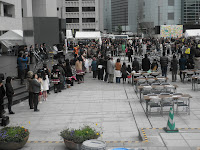






March 24, 2012
March 2011 catastrophe links 2 young men to launch mutually complementary relief activities
Hiroki Saijo, a native of Minami Sanriku Town, Miyagi Prefecture, and Kotaro Ohgami of Fukuoka City of Fukuoka Prefecture did not know each other before the catastrophe of March 11, 2011. But a piece of information Saijo placed on a website after the disaster to seek help for affected people in his home town caught Ohgami’s eye. Saijo had nothing to provide to affected people in Minami Sanriku, but he had knowledge about the situation in the town--that it, where the survivors are and what they need.
Ohgami, who leads a volunteer group based in Fukuoka, was thinking about how to start relief activities for the evacuees when he found Saijo’s message on the Internet. His group, called Fukuoka Front Line Support, hoped to supply relief goods to survivors in small and remote communities who tended to be left out of relief activities by public and big organizations. So, specific information provided by Saijo was helpful for his group. (The photo at the top shows, from left to right, Mr. Ohgami, his daughter and Mr. Saijo.)
Saijo works with an Internet service company in Tokyo. His family lives in an inland city west of Minami Sanriku, but some relatives and friends were in the affected town. He hurried home from Tokyo and then entered Minami Sanriku five days after the disaster. While staying at his uncle’s house, which had been unaffected, Saijo continued to support relief groups from other regions, including Ohgami and his staff, who were unfamiliar with the local situation. The mutually complementary activities by the two young men started in May and continued every time when Ohgami’s group visited Minami Sanriku.
When the earthquake-triggered tsunami waves began to hit widely scattered areas on the Pacific coasts from the Tohoku region of northeastern Japan to eastern Japan, Saijo’s grandmother was attending a party for a club of elderly people at a building in the town.
After the first attack of the earthquake hit the area, some participants fled out of the building, for fear that it would be flooded with tsunami waves. But employees at the building persuaded other people to stay while warning it would be rather dangerous to go out. His grandmother escaped from the third floor to the fourth floor and then to the roof. Those who were at the roof of the building survived, but those who had gone out for safer places were mostly dead, Saijo recalls.
His mother worked as a nurse at Shizukawa Hospital, located in the heart of Minami Sanriku, for about 30 years until a few years ago. After the debris was removed from around the damaged hospital building, a corner was set up near its entrance to receive flowers for about 70 victims there. Saijo told his mother, “Why don’t we go to the hospital?” But she never wanted to go there. “Maybe, it (the hospital) was no more a place for her to see,” he said, “because patients whom she knew and her former colleagues were among the dead.”
Ohgami organized a charity bazaar in Fukuoka along with other volunteer group leaders on the first anniversary of the March 11 disaster. He invited Saijo to come and help volunteers at the event. The Rainbow Square event included performances and shops of foods and goods as donations to affected people. The event was supported by members of about 10 different activist groups, who cooperated with each other across the walls of their organizations. The cross-organizational event style "will help them (the members) to increase their motivations for volunteer activities and make our entire relief activities more successful," said Masakatsu Hiyakawa, a key member of the Fukuoka Citizens' Network for Support to the Disaster Areas.
-"We will continue our activity for survivors for at least 10 years"-
Ohgami stressed the uniqueness of a paint art corner in which visitors paint a big rainbow with their hand prints together on nine separate panels one by one. The panels, when completed, were put together and displayed on the performance stage. “We will continue this rainbow painting activity” in the years ahead, Ohgami said. He hopes that the completed rainbow art panels will be displayed at a public place. He believes that activities for the tsunami-affected people and regions must be continued over the years. Saijo agreed. “We will continue our activities for at least 10 years,” Ohgami said.
-Fukuoka citizens form human chain to mourn disaster victims-
One block away from a shopping mall corridor as the venue of the Rainbow Square bazaar was a much bigger event organized by the Fukuoka city government with public and private organizations. The event was designed to mourn the disaster victims and increase people’s awareness about the importance of extending support in various styles to the survivors.
With about 30 booths set up at a square in front of the city hall building, volunteer and other groups introduced their relief activities and charity goods for the affected people. The “Never Forget March 11” event culminated into one minute of silent tribute for the disaster victims by about 1,500 Fukuoka citizens, who braved a piercing wind to form a big human ring hand in hand at 2.46 p.m., the exact moment of the unprecedented earthquake a year ago.
No comments:
Post a Comment